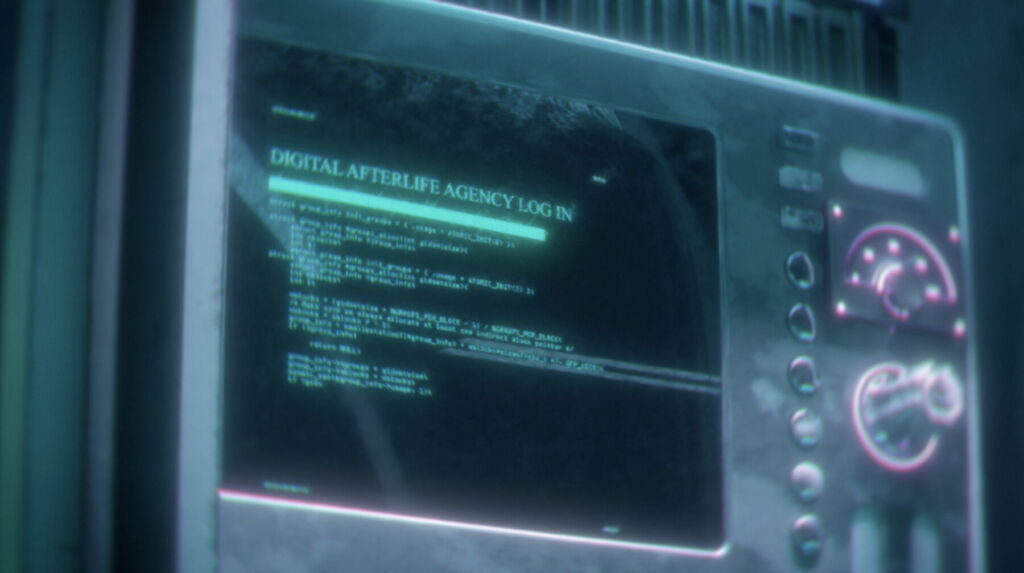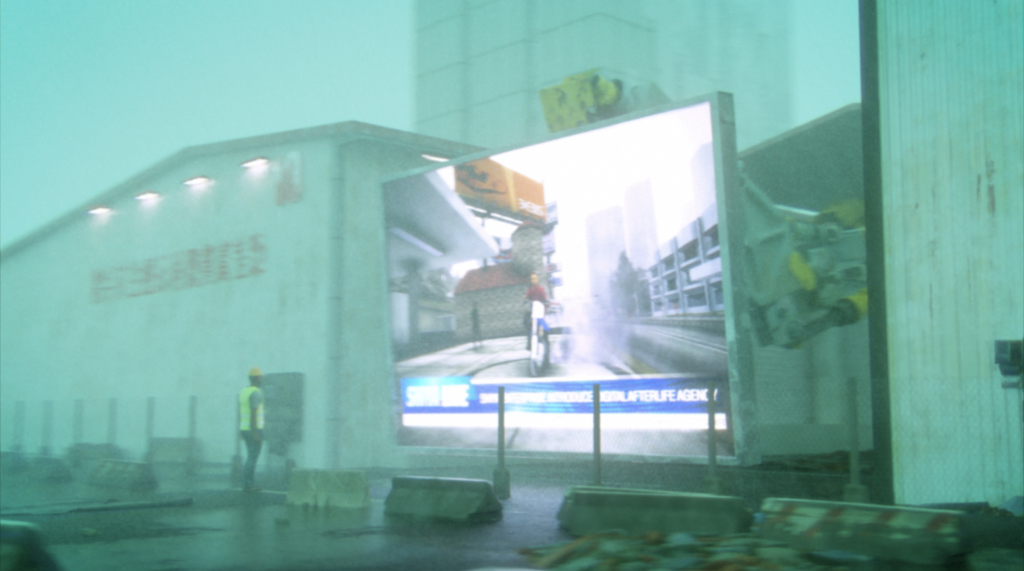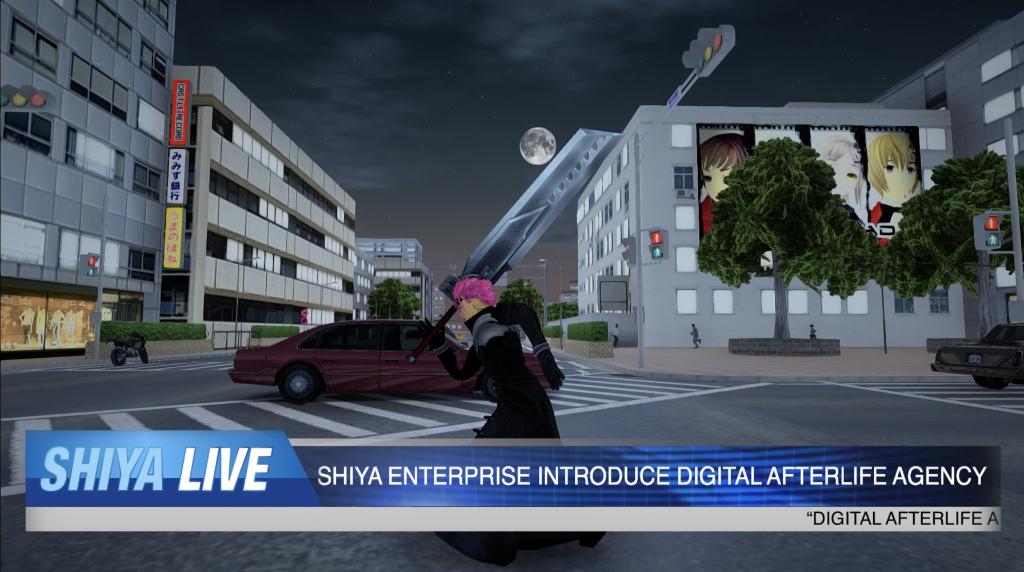Interview by Christopher Michael

Yuen Hsieh is an artist who wishes to [usher] in a new era where imagination and technology coalesce in breathtaking harmony. While, on the surface, this may feel like a lofty task, his work to date has pushed the boundaries of what art can be in our increasingly virtual world, and he has pushed the bounds of what it means to be a working artist in 2023.
Hsieh has established himself as a multimedia juggernaut, moving seamlessly between fashion, video games, rave culture, filmmaking and design. He works equally at home with fashion brands like Burberry and Fendi and game designers and software developers. Despite his movement between genres and mediums, Hsieh has a unique sensibility focused on the dynamic interplay between technology and artistic expression. An artist born into and emblematic of the digital age, Hsieh incorporates cutting-edge technologies like artificial intelligence into his work in a way that feels organic and ultimately human.
By harnessing the potential of digital tools and techniques, Hsieh creates immersive environments that challenge our perception of reality and encourage us to question the impact of technology on our daily lives. For instance, his recent work Digital Afterlife Agency considers technological immortality and digital afterlives in the age of the metaverse and AI.
Following a fictional agency which provides after-death services through a video game-like platform, Hsieh poses the issues and possibilities surrounding modern technology and immortality. In this work, Hsieh considers both the potential benefits of such software, like expanding one’s lifespan or aiding in the grieving process, while highlighting their issues, like problems surrounding the ownership of one’s data and privacy.
While he ultimately holds a positive view towards the power of contemporary technology, Hsieh also wishes to expose the potential issues embedded within such software. In doing so, he paints a full picture of this emerging field of technology, immersing audiences into a near future where we can extend our lives after death. Hsieh’s work more generally delves deeper into themes surrounding the relationship between humans and machines, exploring the evolving dynamics in our increasingly digitised society.
Hsieh focuses on how digital culture can provide space for exploring identity and cultural heritage while simultaneously subverting societal norms. He holds an optimistic view toward the capacity for virtual worlds to change culture.
Through his art, he prompts us to reflect on the effects of technology on human connection, identity and the ethical implications of emerging technologies. With a keen eye for detail and a profound understanding of the complexities of our digital age, Hsieh’s work catalyses dialogue and introspection, pushing us to reconsider our relationship with technology and the boundaries of artistic expression in the 21st century.



You are an artist who works with various digital instruments, like AI, NFTs, and 3D design. Please tell us briefly about your work and how your practice utilises these tools.
I am a director / visual artist / DJ born in Taiwan and educated in London. I went to Central Saint Martins and the Royal College of Art to study fine art and Design Interaction. As a director and visual artist, my work revolves around the dynamic interplay between technology and artistic expression. I embrace the cutting-edge tools of our digital era, harnessing the power of AI and 3D design to push the boundaries of creativity. I was working as a creative director for a start-up English game company last year to create a series of NFT based on the characters from the video game.
In essence, my work as a director and visual artist is a testament to the transformative power of technology. By embracing AI, and 3D design, I can forge a creative path that challenges the norms of traditional art and invites audiences to embark on a journey of innovation and exploration.
Through the seamless fusion of these digital instruments, I strive to redefine the limits of artistic expression, ushering in a new era where imagination and technology merge in breathtaking harmony. Much of your work pulls inspiration from various sources, like video games, internet subcultures, and the fashion world. What are some of your aesthetic inspirations, and how do they factor into your practice?
In my practice, I draw inspiration from various sources, including video games, internet subcultures, and the fashion world. These diverse aesthetic influences play a significant role in shaping my artistic vision and informing the creative choices I make.
I’m fascinated by video games’ immersive worlds, imaginative storytelling, and visually striking designs. Video games’ dynamic and interactive nature inspires me to create artworks that engage the viewer and invite them to participate actively in the visual narrative. I often incorporate elements of game aesthetics, such as vibrant colours, futuristic themes, and a sense of adventure or exploration.
With their distinct visual languages and communities, Internet subcultures inspire me. The internet is a treasure trove of creativity, from memes and digital art movements to online fandoms and underground scenes. I find inspiration in the DIY spirit, remix culture, and rebellious energy. Incorporating elements like glitch art, pixel art, or surreal visuals into my work allows me to tap into the visual vocabulary of these subcultures and create artwork that resonates with their sensibilities.
The fashion world is another significant source of inspiration for me. I’m captivated by the power of fashion to communicate identity, express emotions, and challenge societal norms. The history of techno and rave music is closely intertwined with fashion, as both movements emerged and evolved simultaneously, influencing and inspiring each other in creative and dynamic ways.
The subculture’s fashion choices have always been about more than style; they reflect a sense of freedom, rebellion, and creative self-expression. The distinctive aesthetics of the techno and rave scenes have left a lasting impact on both underground and mainstream fashion, showcasing the power of music and style to shape cultural movements and inspire creativity.
By blending these aesthetic inspirations, I strive to create a visual language that is uniquely my own. I aim to evoke a sense of hybridity, where the boundaries between different influences blur, and new narratives emerge. By combining diverse aesthetics, I can create artwork that reflects the diversity of our contemporary culture and resonates with a broad range of viewers. I started a party table, AUDIO RIOT, a few years back, and we invite DJs, artists, and engineers to collaborate with us. I also met friends from all over the world as a DJ.
Ultimately, these aesthetic inspirations factor into my practice by informing my visual choices, shaping the themes and narratives I explore, and allowing me to connect with a diverse audience that appreciates the intersections of art, gaming, internet culture, and fashion. By embracing these varied influences, I seek to create visually compelling, thought-provoking artwork that speaks to the ever-evolving nature of our modern world.
Your most recent film, Digital Afterlife Agency, imagines a world where we can upload our data to reach a kind of digital immortality. Where did the inspiration for this work come from?
The inspiration for my film, Digital Afterlife Agency, stemmed from a combination of factors and influences shaping our modern relationship with technology and our growing fascination with the concept of digital immortality.
I was first compelled to work on this subject following profound personal crises: My mom got ovarian cancer three years ago. It spread to her other organs, like her lungs and other places. During Covid, travelling from Shanghai to Taiwan to visit your family was like forty-two days of quarantine. Only after that were you able to see someone you wanted to, someone you loved.
Subsequently, I began to research life and death processes, including modern approaches to euthanasia. It’s not legal in many countries. I was also inspired by a Taiwanese man who visited Switzerland to avail of euthanasia services provided there. I wanted to examine the right to choose whether you want to live or die. How you want it to be like a rave party or cosplay gathering depends on your agreement and contrast.
In the face of personal tragedy and loss, as I mourn the peaceful passing of my beloved mother this year, I have been granted an extraordinary opportunity by the prestigious Sónar Festival. With profound gratitude, I have been invited to share my transformative project, Digital Afterlife Agency, on its illustrious stage.
This remarkable platform offers me the chance to honour my mother’s memory but also to impact the lives of others profoundly. Together, we will embark on an awe-inspiring journey, raising collective awareness and igniting a passionate dialogue about the boundless potential of digital immortality. In this poignant convergence of grief, artistry, and technology, we will explore the depths of our humanity and the enduring power of love that transcends the boundaries of time and space.
I developed an idea for a fictional organisation providing services that promised dignified death and transition. This organisation would also allow one to choose another character or avatar for one’s afterlife. The video game visuals recall settings where players (the ones ostensibly in charge of their life) can select everything, from dress to destiny. The digital afterlife is a video game – all you need to do is give up yourself.
The rapid advancement of technology and the increasing integration of digital tools into our daily lives have sparked discussions and speculation about the potential for achieving some form of digital immortality. Concepts such as uploading one’s consciousness, preserving memories, or creating virtual representations of ourselves have captured the public imagination and raised questions about the implications and possibilities of such scenarios.
Exploring identity and the evolving nature of self-expression in the digital age have been recurring themes in my artistic practice. Extending our presence beyond our physical existence and the concept of a digital afterlife offered a compelling framework to delve into these themes and explore the intersection of technology, identity, and mortality.
Societal discussions surrounding data privacy, ownership, and the ethical implications of emerging technologies have also influenced the development of the film. The notion of surrendering personal data and control over one’s identity in exchange for digital immortality raises thought-provoking questions about the potential consequences and power dynamics in a technologically driven world.
Drawing from these inspirations, Digital Afterlife Agency aims to spark conversations and reflections on the impact of technology on our lives, our concepts of self, and the ethical considerations surrounding digital immortality.
It serves as a commentary on the complex relationship between humanity and technology, inviting viewers to ponder the potential ramifications and societal implications of pursuing digital immortality. By exploring these themes in a narrative format, the film aims to engage and challenge viewers to reflect on how technology shapes our understanding of life, death, and the essence of being human.
In Digital Afterlife Agency, users are promised a world where they can be ‘whoever they want to be’ after uploading their data. A theme of your more significant work is exploring identity on the internet. In your opinion, how do virtual spaces allow us to play with our perceptions of self?
Virtual spaces provide us with a unique opportunity to explore and play with our perceptions of self. They offer a canvas to experiment with different identities, transcend physical limitations, and reimagine who we are or want to be. This ability to shape and present our identity in virtual spaces can be liberating, empowering, and transformative.
Virtual spaces allow us to play with our perceptions of self by creating avatars or digital personas. Avatars are extensions of ourselves, allowing us to embody different characteristics, appearances, and personalities. They provide a sense of agency and freedom to explore facets of our identity. We can experiment with different aspects of our identity.
Additionally, virtual spaces provide a platform for self-expression and social interaction, enabling us to connect with others who share similar interests, passions, or identities. Online communities and virtual worlds can be spaces of belonging and acceptance where individuals can find support and forge connections based on shared values or experiences. This sense of community can empower individuals to explore and embrace aspects of their identity that may be marginalised or stigmatised offline.
Furthermore, virtual spaces often offer anonymity or pseudonymity, which can liberate individuals from the constraints and judgments associated with their physical identity. This anonymity can create a safe environment for self-exploration, where individuals can freely experiment, express themselves authentically, and challenge societal norms without fear of judgment or repercussions. In these spaces, individuals can question, deconstruct, and reconstruct their self-perception, allowing for personal growth and self-discovery.
However, it is important to note that virtual spaces also have limitations and potential risks. The boundary between the virtual and real world can sometimes become blurred, leading to issues of identity authenticity, online harassment, and ethical dilemmas. It is crucial to approach virtual spaces with critical thinking, empathy, and respect for others’ boundaries and consent.
In summary, virtual spaces provide a playground where we can playfully explore, experiment, and redefine our perceptions of self. They offer self-expression, connection, and personal growth opportunities, allowing us to transcend physical identity’s limitations and embrace our individuality’s diversity and fluidity. By engaging with virtual spaces mindfully, we can harness their potential to expand our understanding of self and foster a more inclusive and empathetic society.
An issue in Digital Afterlife Agency is that once users upload their data, the D.A.G owns it, and people lose their freedom. Does this mirror any real-world concerns you have about data/privacy on the internet today?
Yes, the ownership and control over personal data in the context of a Digital Afterlife Agency (D.A.G) reflects real-world concerns about data privacy on the internet today. The concept of users relinquishing ownership and control over their data upon uploading it to a centralised entity raises important questions about privacy, autonomy, and the potential for misuse or unauthorised access.
In the digital age, individuals generate vast amounts of personal data through their online activities, including social media posts, browsing history, and interactions with various platforms and services. This data can reveal intimate details about individuals’ lives, preferences, and behaviours. As such, it is crucial to have mechanisms that protect individuals’ privacy rights and ensure they control how their data is collected, stored, and used.
One of the key concerns in today’s internet landscape is the increasing consolidation and centralisation of data by a few powerful entities. This concentration of data in the hands of a select few raises questions about data ownership and control and the potential for data breaches, unauthorised access, or exploitation for commercial or surveillance purposes. Users may feel they have lost their freedom and agency over their digital identities as their personal information becomes manipulated and monetised without their explicit consent.
Furthermore, emerging technologies like artificial intelligence and machine learning rely heavily on access to large datasets. This raises concerns about the ethical use of personal data, as it can shape or manipulate individuals’ experiences, influence decision-making processes, or perpetuate bias and discrimination.
There is a growing call for more robust data protection regulations, transparency in data collection and usage practices, and increased user empowerment and control over personal data to address these concerns. Privacy laws such as the European Union’s General Data Protection Regulation (GDPR) and the California Consumer Privacy Act (CCPA) are examples of efforts to provide individuals with more rights and protections regarding their personal data.
In summary, the issue of ownership and control over personal data in a Digital Afterlife Agency mirrors real-world concerns about data privacy and autonomy on the internet. It highlights the need for robust data protection measures, increased user control, and ethical considerations surrounding data usage, ensuring that individuals maintain their freedom and agency over their digital lives.
Gaming and expanded realities are pushing narrative and storytelling into all sorts of new different territories. What is your personal experience about it? And where do you see these new forms of narratives moving into artistic practices?
As a director and visual artist, I have personally witnessed the profound impact of gaming and expanded realities on narrative and storytelling. These mediums have opened up a new realm of possibilities, blurring the boundaries between fiction and reality and allowing audiences to participate actively in immersive, interactive experiences.
Gaming, in particular, has revolutionised storytelling by offering dynamic, non-linear narratives that adapt to player choices and actions. This interactive element creates a sense of agency and engagement, enabling players to shape the story and connect with the characters on a deeper level. As a result, gaming narratives have become more nuanced, complex, and personalised, resonating with players in profound ways.
Expanded realities, including virtual reality (VR) and augmented reality (AR), have taken storytelling to even greater heights. VR transports viewers into fully immersive virtual worlds to explore and interact with the narrative environment. This level of immersion allows for deeply empathetic and transformative storytelling experiences.
AR, on the other hand, overlays digital elements in the real world, creating a blend of virtual and physical reality. This allows artists to create interactive installations, public art interventions, and location-based narratives that merge the tangible and the digital in captivating ways.
These new forms of narratives are pushing artistic practices into uncharted territories. They offer artists the ability to create multisensory experiences that engage audiences on multiple levels – visually, audibly, kinesthetically, and emotionally. Artists can craft immersive worlds, design complex characters, and experiment with branching storylines that adapt to individual choices and actions.
Furthermore, these new narrative forms are breaking down barriers between art forms. Artists can combine visual art, sound design, animation, and game design elements to create holistic experiences that transcend traditional boundaries. This interdisciplinary approach allows for exploring themes and ideas in innovative and impactful ways.
These new forms of narratives will continue to evolve and become even more integrated into artistic practices. We expect technological advancements to enhance immersion, realism, and interactivity. Artists will harness these tools to create increasingly sophisticated and emotionally resonant narratives that challenge our perceptions and invite audiences to engage with the storytelling process actively.
Moreover, I envision greater convergence between the gaming, film, and art industries. Collaborations between game developers, filmmakers, and visual artists will give rise to hybrid experiences that combine each medium’s best elements, offering audiences groundbreaking narrative encounters.
Ultimately, these new narratives will continue to push artistic practices into unexplored territories, empowering artists to create transformative, interactive, and emotionally impactful experiences. By embracing the possibilities of gaming and expanded realities, artists will redefine storytelling, inviting audiences to become active participants in immersive worlds where the boundaries between art and life dissolve.
Part of your work is focused on fashion; how do you think these technologies you use and the new visual and storytelling narratives are evolving within the fashion creative world?
Integrating technologies like AI, NFTs, and 3D design has profoundly transformed visual and storytelling narratives within the fashion creative world. These technologies have opened up exciting avenues for experimentation, collaboration, and expression, revolutionising how fashion is conceived, created, and communicated.
Firstly, AI has emerged as a powerful tool in fashion, facilitating everything from trend forecasting and design assistance to personalised shopping experiences. Machine learning algorithms can analyse vast amounts of data, enabling designers to gain insights into consumer preferences, market trends, and cultural shifts. AI can generate design variations, aiding in the ideation and prototyping process while also helping to optimise production and supply chains.
Moreover, AI-driven virtual models and influencers have made their mark, transcending physical limitations and challenging traditional notions of representation in the fashion industry. These virtual personalities enable designers to experiment with diverse aesthetics and create compelling digital campaigns that resonate with global audiences.
NFTs have brought about a paradigm shift in fashion by revolutionising ownership, authenticity, and collectibility. Fashion brands and designers can tokenise their creations as unique digital assets, granting collectors and consumers exclusive ownership rights. This technology provides a new revenue stream for designers and fosters a direct connection between creators and their audience, enabling a deeper engagement and sense of community.
In terms of visual narratives, 3D design has unleashed a world of possibilities in fashion storytelling. With advanced software and tools, designers can create immersive virtual experiences, virtual fashion shows, and digital showrooms that transcend physical limitations. This opens up opportunities to explore fantastical worlds, push the boundaries of imagination, and create narratives that intertwine with technology, art, and culture.
Additionally, the rise of social media and digital platforms has democratised fashion, allowing emerging designers and independent creators to reach a global audience. The accessibility of these platforms, coupled with the use of technologies, has enabled diverse voices and narratives to emerge, challenging traditional hierarchies and offering new perspectives on fashion aesthetics and cultural identities.
These technologies and evolving visual and storytelling narratives drive innovation, collaboration, and inclusivity in the fashion creative world. They are breaking down barriers and redefining how fashion is conceptualised, consumed, and experienced. By embracing these transformative tools, fashion is becoming more dynamic, interactive, and reflective of our technologically advanced society while opening up possibilities for sustainability, customisation, and immersive experiences.
What is your chief enemy of creativity?
External factors such as societal norms, criticism, and comparison can also act as adversaries to creativity. The pressure to conform to established standards and fit into predefined moulds can stifle our unique perspectives and hinder our willingness to take artistic risks. The fear of judgment and the desire for validation can lead us to suppress our authentic artistic voice, limiting our ability to think outside the box and express ourselves authentically.
To combat these enemies of creativity, it is crucial to cultivate self-belief and resilience. Embracing a mindset of acknowledging failure as a stepping stone to growth and learning can help us overcome the fear of making mistakes. Surrounding ourselves with a supportive and nurturing community that celebrates creativity and encourages risk-taking can provide the encouragement and feedback needed to persevere. Practising self-care, mindfulness, and reflection can also help during the past three years when I am away from the world.
One for the road… What are you unafraid of?
I am unafraid of embracing the unknown. The vast expanse of uncharted territory, whether in art, technology, or life itself, holds immense growth, discovery, and innovation potential. I thrive on the thrill of venturing into unfamiliar realms and pushing the boundaries of what is considered possible.
By embracing the unknown, I open myself up to new ideas, perspectives, and experiences. I am unafraid of challenging conventional wisdom, questioning established norms, and stepping outside my comfort zone.
This fearless exploration allows me to uncover hidden gems, unearth unconventional solutions, and create groundbreaking work that resonates with authenticity and originality.
Fearlessness in the face of the unknown drives me to experiment, take risks, and continuously evolve as an artist and individual. It fuels my curiosity, propels me forward, and empowers me to transcend limitations and manifest visions that were once deemed impossible.
By embracing the unknown, we can unlock our creative potential and make a meaningful impact. Rather than being daunted by uncertainty, it is an invitation to embark on an exhilarating journey of discovery, innovation, and self-discovery. I welcome the unknown with open arms, for within it lies the infinite realm of possibilities waiting to be explored and brought to life.





